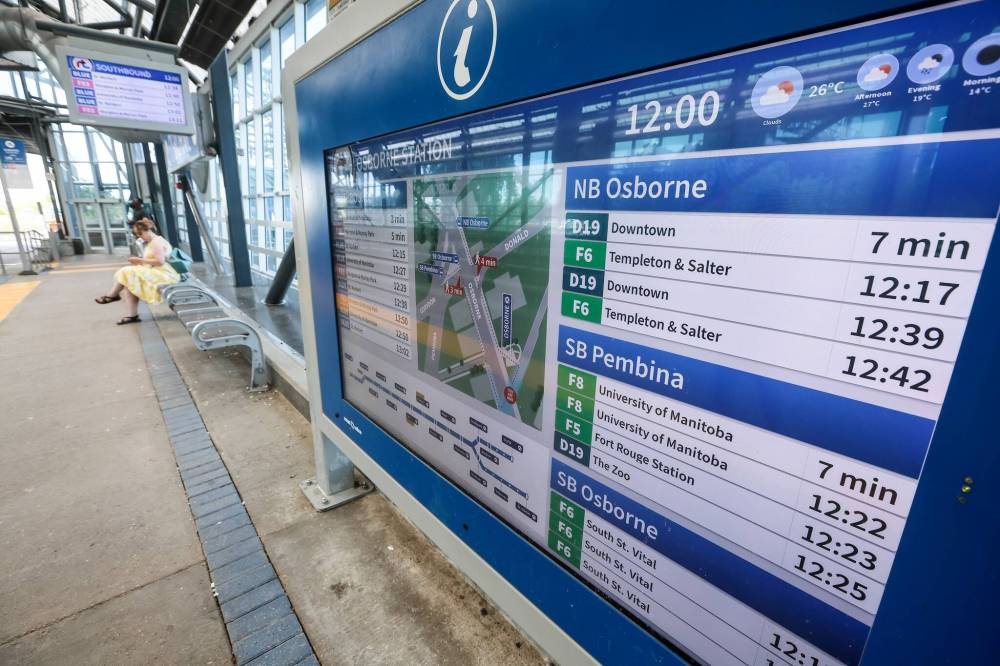Transit system overhaul: lofty goals, but fixes needed
Advertisement
Read this article for free:
or
Already have an account? Log in here »
To continue reading, please subscribe:
Monthly Digital Subscription
$0 for the first 4 weeks*
- Enjoy unlimited reading on winnipegfreepress.com
- Read the E-Edition, our digital replica newspaper
- Access News Break, our award-winning app
- Play interactive puzzles
*No charge for 4 weeks then price increases to the regular rate of $19.00 plus GST every four weeks. Offer available to new and qualified returning subscribers only. Cancel any time.
Monthly Digital Subscription
$4.75/week*
- Enjoy unlimited reading on winnipegfreepress.com
- Read the E-Edition, our digital replica newspaper
- Access News Break, our award-winning app
- Play interactive puzzles
*Billed as $19 plus GST every four weeks. Cancel any time.
To continue reading, please subscribe:
Add Free Press access to your Brandon Sun subscription for only an additional
$1 for the first 4 weeks*
*Your next subscription payment will increase by $1.00 and you will be charged $16.99 plus GST for four weeks. After four weeks, your payment will increase to $23.99 plus GST every four weeks.
Read unlimited articles for free today:
or
Already have an account? Log in here »
Winnipeg Transit’s long-awaited route overhaul rolled out last month, promising faster travel times, more frequent service, and a simplified network aimed at improving overall efficiency.
As expected, some are happy with the new system, others, not so much.
Let’s start with the good news. Some riders are experiencing faster travel times, particularly those who live near major routes now serviced by high-frequency buses. These “spine” routes — running down major corridors such as Portage, Main and Pembina — were designed to act as the backbone of the new system, with buses arriving every 10 to 15 minutes.

JOHN WOODS / FREE PRESS
Transit schedule changes at Osborne Station
But that’s where the good news ends.
The new network, in its attempt to streamline service and focus on efficiency, has removed or consolidated many neighbourhood routes and stops. The result? Thousands of riders now have to walk significantly farther just to catch a bus. In a city like Winnipeg, where winters are brutally cold and sidewalks often go unplowed, that’s no small inconvenience.
Many passengers have also lost their one-seat rides. Trips that used to take one bus now require two, sometimes three. Come January, standing around waiting for a second or third bus in -30 C weather won’t just be unpleasant, it will turn many off using transit — the very opposite of what the city is trying to achieve with the new bus network.
Meanwhile, the situation was made worse last week by a technical failure that couldn’t have come at a worse time. Winnipeg Transit’s real-time GPS tracking system, which riders have come to rely on through apps and online schedules, began faltering days after the launch. Buses weren’t showing up on tracking apps, posted arrival times were inaccurate, and riders were left wondering whether their bus had already passed or was running late.
That confusion sowed more frustration among passengers already trying to navigate an unfamiliar network.
Transit officials argue that the changes will take time to adjust to, and that’s true. Big transitions are always disruptive, especially when they affect tens of thousands of daily riders. They’ve also said the redesign is meant to be a living system — something that can evolve with feedback. But let’s face it: the rollout, so far, has not inspired much public confidence.
The city must listen closely to rider feedback, not just from those who live along the new high-frequency corridors, but from everyone who uses the system. That includes students commuting to university, shift workers travelling early in the morning or late at night (some of whom have seen their late-night bus service disappear and are forced to take taxis or an Uber to get home), and people with limited mobility.
Transit must act quickly. That means fixing the GPS issue immediately, improving signage and information at transfer points, and being open to reinstating or adjusting routes that aren’t working (Transit has said no route changes will be made for a year, something they may want to reconsider).
In the longer term, this redesign must be coupled with a commitment to invest in infrastructure that supports it. That includes more heated shelters at transfer points, more accessible sidewalks and paths, and winter maintenance that ensures people can reach their bus stops without risking injury.
The goals behind the overhaul are laudable: faster, more efficient service, a network that better reflects how Winnipeggers move around the city, and a system ready to support future growth. But any transit system must work for everyone — not just the able-bodied and centrally located.
It’s not enough to say “wait and see.” People are missing work, appointments, and connections right now. The city owes it to them to fix what’s broken — before the snow starts to fall.





